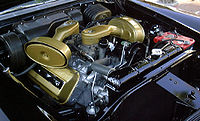
Photo from wikipedia
48V systems enable not only mild hybrid functionalities such as recuperation or torque assist by a belt-driven starter generator (BSG), but also electrification of accessories and the engine boosting system.… Click to show full abstract
48V systems enable not only mild hybrid functionalities such as recuperation or torque assist by a belt-driven starter generator (BSG), but also electrification of accessories and the engine boosting system. To maximize the powertrain efficiency, a proper layout of the electrified system and an optimized distribution of the electric power during transient operation is essential. In this study, a vehicle co-simulation of a conventional powertrain with a downsized turbocharged gasoline engine is extended by a 48V system with an electric compressor (eC) and a BSG. The control functions of the eC and BSG are based on a state-of-the-art vehicle application and calibrated for transient operating conditions. The engine model, which is built using a one-dimensional crank angle resolved approach in GT-POWER, has been validated with measurement data and is used to predict the interaction between the eC and the engine air path. The investigations using the simulation platform show that the 48V eC and the BSG can significantly improve the fuel effïciency if the electric energy consumption is initially neglected. However, when considering the electric energy consumption within the vehicle co-simulation, efficient operation is particularly depending on driver torque demand, the battery state-of-charge and charging effïciency. Hence, intelligent operating strategies are necessary to take advantage of the better torque response and improve fuel consumption at the same time.
Journal Title: Proceedings of the Institution of Mechanical Engineers, Part D: Journal of Automobile Engineering
Year Published: 2020
Link to full text (if available)
Share on Social Media: Sign Up to like & get
recommendations!